Native American Winter Stories
Air Date: Week of December 20, 2019
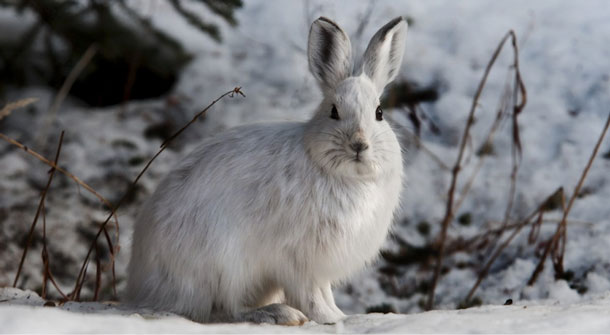
Rabbits are often portrayed as playful and humorous tricksters amongst Native American communities. They have strong hearing abilities and are fast runners, which protects them from predators. (Photo: National Science Foundation, CC By 2.0)
Since the beginning of human time storytelling has long been a way to pass down cultural knowledge and myth. Joe Bruchac, a renowned writer and storyteller from the Nulhegan Abenaki tribe, joins Host Steve Curwood to share Native winter stories and traditions.
Transcript
CURWOOD: It’s Living on Earth, I’m Steve Curwood.
Joe Bruchac is an elder in the Nulhegan Abenaki tribal family of upstate New York and Vermont. He’s an author of more than twenty books and a storyteller and he joins us now. Joe, welcome back to Living on Earth. How are you?
BRUCHAC: I'm doing well thank you.
CURWOOD: And you have a story for us for this season.
BRUCHAC: Yes, I do one that seems pretty appropriate considering the snow is falling right now.
CURWOOD: Let's take a listen then please.
BRUCHAC: A long time ago they say rabbit was one of the fastest runners in the forest, and also had a long beautiful tail. But rabbit loved one thing more than anything else. He loved to run around and play in the snow. Now this particular day, the snow had not fallen, and rabbit was disappointed but then he got an idea. His grandmother had told him
RABBIT’S GRANDMOTHER: "Rabbit, sometimes if you want to make something happen, if you sing a song and dance, it will happen for you"
BRUCHAC: And rabbit thought that was a good idea. So he made up a little song and began to dance in a circle singing
RABBIT: "If only it would snow, if only it would snow, then I could run around and play if only it would snow."
BRUCHAC: And sure enough, snow began to fall. And before long, there was enough snow that he could see his footprints going in a big circle. and he was very pleased. But then he thought to himself,
RABBIT: "If a little snow is good, more snow would be better".
BRUCHAC: And so once again, he began to sing and dance in a circle
RABBIT: "if only it would snow, if only it would snow, then I could run around and play, if only it would snow"
BRUCHAC: And indeed, more snow fell, it began to fall even harder with bigger flakes, and soon the whole ground was covered deep in snow. But as rabbit looked around, he said to himself, "
RABBIT: “If a little more snow is better, then a lot more snow would be even better still".
BRUCHAC: And so once again, he began to sing and dance in a circle
RABBIT: "If only it would now, if only it would snow, then I could run around and play, if only it would snow"
BRUCHAC: And now huge snowflakes the size of feathers began to fall from the ground. The snow covered up the bushes, but rabbit kept singing. The snow covered up the bottoms of the trees, but rabbit still kept singing. He looked around and said,
RABBIT: "Hmm, if a not more snow is good, then even more snow would be even better!"
BRUCHAC: And he began again to sing and dance
RABBIT: "If only it would snow, if only it would snow, then I could tun around and play if only it would snow"
BRUCHAC: And now the smaller trees were covered, and soon the bigger trees recovered and finally every tree in the forest was covered with snow. In fact, all you could see sticking up from the top of that snow was the top of the very tallest tree. And that is when rabbit decided he'd done enough. In fact, he was feeling a little tired. He looked around and he said
RABBIT: "Oh, I did a really good job, there is snow everywhere but now I think I should go home and and take a nap and oh, my home".
BRUCHAC: Indeed, where was rabbit's home? It was buried deep under all that snow and he was feeling really tired. But when he looked around, what did he see at the top of that one tallest tree? The fork of that tree sticking up above the snow, and he climbed into that fork of that tree, curled up, wrapped his long, beautiful tail around himself and fell asleep. He slept for a long time. In fact, this was the time of year when the snow begins to disappear. And the sun as it shone down did just that. It began to melt the snow away, down from the tops of the trees down from the middle of the trees down below the bushes and soon all the snow was gone, and rabbit was still asleep in the top of that tree. Before long ago, he woke up, stretched and said,
RABBIT: "Oh, that was really good but now Oh, Oh"
BRUCHAC: He looked around and realized he was in the top of a tree and back then, even as now, rabbits do not know how to climb up trees or climb down. He was stuck up there and unsure about what to do next. He thought:
RABBIT: "Maybe I could sing and dance in a circle but not in this small space".
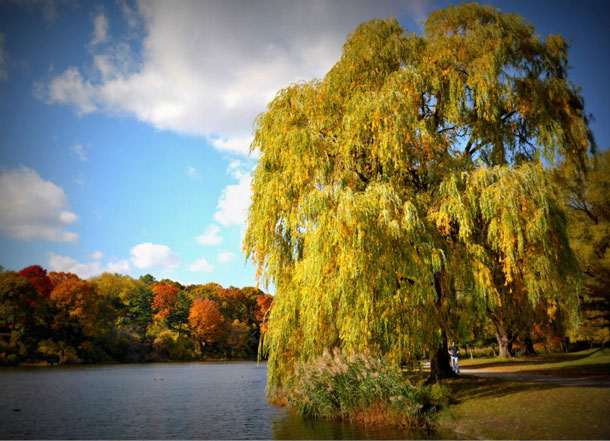
Willow trees prefer cool moist soil and are commonly found near streams, river, ponds, wetlands and floodplains. The rabbit tail story suggests that the elongated leaves on willow trees are rabbit tails that got stuck on a tree branch. (Photo: Jonathan Lines, Flickr, CC By NC ND 2.0)
BRUCHAC: He could not make it snow again with his song and his dance. What could he do? He leaned, leaned, leaned further looking down toward the base of that tree and down there he saw a little green plant growing that looked delicious. Rabbits like to eat green plants and he thought,
RABBIT: "Oh, I'm so hungry if only I could reach that plant found there".
BRUCHAC: He leaned a little further. In fact, he leaned too far, and began to fall. And as he fell, he bounced off one branch, then another branch, and each time he bounced off a branch, a little piece of his tail came free and stuck there. And when he hit the ground, he hit so hard, this front legs got all pushed in, so that now instead of running swiftly, he had to hop and when he looked up in the tree, and saw all those pieces of his tail, and then look back at himself, all he had left was a little round tail where once that long, beautiful tail had been. And so it is to this day, that rabbit has a short tail. Indeed, in the springtime, if you look up into certain trees, some say the pussy willows, others say the cottonwood trees you can see those fluffs left from rabbits tail stuck up there when long ago, rabbit made it snow more than he needed to. And that is how that tail like rabbits ends.
CURWOOD: So, the moral of that story, I guess is be careful what you ask for.
BRUCHAC: Well be careful what you're asked for, but also be satisfied when you have enough too much is not necessarily a good thing.
CURWOOD: No, it isn't. Joe, do you have another story for us today?
BRUCHAC: Well, one story that we tell at this time of year reminds us that we need to take care of our children. In fact, it is said that not that long ago, a mother and a father were out walking in the woods with their little daughter, who was only about perhaps four winters old. We reckon age in terms of winters because if you've lived through a winter, you've lived through a year. And as they walked along, I'm sad to say that mother and that father were arguing with each other. And as they argued over nothing consequential. Their little daughter noticed something. This particular tree she was looking at was really nice looking. She walked over to that tree and she felt how smooth the bark was. She thought, What a lovely tree then she turned around and said, "Mother, Father, look at this, Ooh". They were nowhere to be seen. They were arguing so hard with each other they had kept walking, leaving her behind. In fact, they kept arguing all the way back to their village. And when they got there, the husband said, "my wife, where's our daughter"? And the wife said, "my husband, I thought you were watching her", and they realized she'd been left behind. And just then, it began to snow. And just then the sun began to go down in the sky. They ran back along the trail but the snow was falling so fast they lost sight of the trail itself. They could not find their daughter, they hurried back to the village. They told everyone what had happened. And you know, one child is everyone's child in a village, and everyone in the village came out to help. They lit torches, they walked through the forest, long, long and long but they did not find that little girl. They were sure that she had not survived, for by now the snow was very deep. But the next day when the sun rose, one man who was a very good hunter had not given up, he kept walking along, and then he saw something. What he saw was the base of a hill covered with snow, and from the base of that hill through a little hole in the snow, steam was rising up. He thought he knew what it was. He went, he looked down through that hole in the snow and what he saw was just what he'd expected.
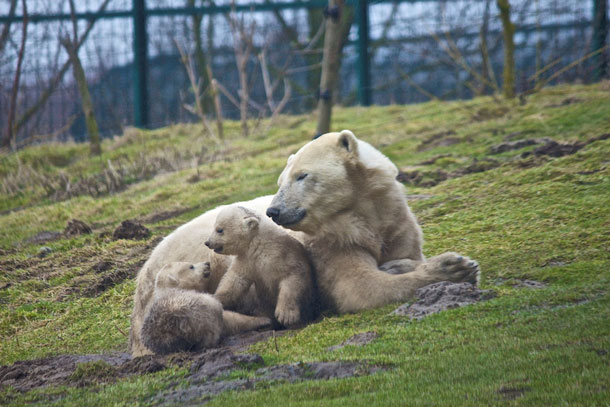
Protecting the young is a quality that both human and animal mothers share. (Photo: Michelle Bender, Flickr, CC By NC ND 2.0)
[FLUTE MUSIC]
It was a mother bear, her breath melted the snow and rose up through that hole as it always does in the winter time. But what he saw, in addition to those cubs made him smile broad, for there was that little girl curled up next to those cubs, warm and safe. He reached down carefully lifted her out and took her home to her parents. Ever since then, we often say when we remember that story that parents should take as good care of their children, as does a mother bear.
CURWOOD: Such an amazing story. When did you first hear that story?
BRUCHAC: I first heard that story about 30 years ago, when I was at out in Wisconsin, a Menominee friend of mine told me that story and said it really happened among their people, it was not a made up story at all. And I have heard other stories, for example, in our Abenaki tradition, about a boy who gets lost or is adopted by the bears, and the bears take care of him until he is finally found by his people. And an old friend of mine named Swift Eagle, who was a Pueblo and Apache elder actually told a story called The Bear Boy about a boy named Kuo-Haya, who was adopted by the bears when he was neglected by his father. So that kind of story apparently travels very well and maybe it's happened more than once.
CURWOOD: Yes, and it's interesting you mentioned the Menominee because among other things, the Menominee are so famous for how they've taken care of their their forests, their woods.
BRUCHAC: Oh yes, they are. In fact Menominee means wild rice people manomin is wild rice, and they are Algonquin speakers as are our Abeniki or Abenaki people. And when the Menominee had their travel recognition taken away from them a number of decades ago, they lost control of their forests. And a lot of them were caught and badly managed. But they managed to regain travel recognition and one of the first things they did was reintroduce the kind of forestry practice they had learned from their elders. Which made sure that the woods would not be clear cut and that they would be used in a sustainable fashion for that gift from the creator of the forest is one that's not meant just for our generation but for all the generations that follow us.
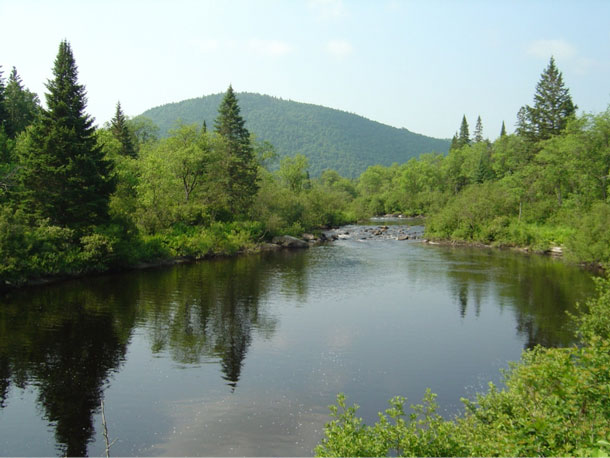
The Nulhegan River is in Northern Vermont, it is surrounded with wildlife like the wild tailed deer, dense moose populations, black bears, and ruffed grouse. Mother Earth can be easily appreciated when looking at a landscape like the Nulhegan River. (Photo: Tom LaPointe, USFWS, Public Domain)
CURWOOD: It's really inspiring. Years ago, I went to visit the Menominee and I met their forester Marshall Pickoff, I believe was his name. And he explained to me that the Menominee only cut the trees that are too old or ill and that as a forester, he was cutting trees that had been designated by the foresters before him that they had been prepared, they would be mature, and that he was going ahead to make preparations for what would be cut in later generations. And I forget the exact numbers but, you know, the Menominee were forced to give up their land, along the lake, Lake Michigan. But they were permitted in negotiations to keep a couple hundred thousand acres of forest land inside. And they decided that this was their legacy forever. And they started with an estimated billion and a half board feet of timber. Over the years, they've harvested over a billion board feet and they have more than what they started with today, because they've only cut with what's too old or too ill to keep growing. It's amazing.
BRUCHAC: Yeah, I should mention that. It was Stephen Marvin Askinet, who was the elder who told me that story when I was visiting Menominee. He since passed on but he was a wonderful tradition bearer. And one thing I I always try to do is to remember to acknowledge those people who shared those stories with me. For example, that rabbit snow dance story can be traced back through people such as Arthur Parker, who was a Seneca storyteller and writer who recorded many of the traditions of his people.
CURWOOD: Well, Joe, we have a bit more time left here and, and I'm wondering if this something else that reminds you of this time of year, the solstice the changing of the season, then getting dark and getting cold and yet all this white that you might want to tell us now?
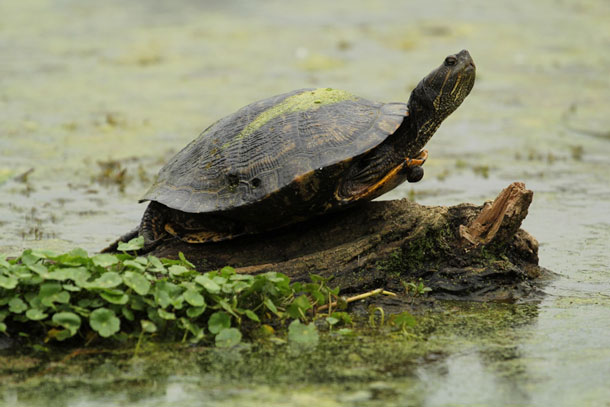
In most Native American communities, the turtle is a symbol of strength fertility and perseverance. There is a strong connection with the turtle and the story of creation. The markings on its back are believed to portray moon cycles. (Photo: Lukas Vermeer, Flickr, CC BY NC SA 2.0)
BRUCHAC: Well, there is a tradition among the Abenaki people which has gone back for a long time, called the New Year's greeting. And it is this when the new year comes, everyone goes from house to house, and they say in the [Abenaki Language]
[ABENAKI GREETING SONG]
Which means, forgive me for any wrong I may have done to you, including wrong that I may not realize I have done to you. For it is important to realize that the things you do affect others around you. And sometimes you may not even know that you've caused a fence or hurt someone's feelings. But at the start of the year, beginning again with those words, were able to have a clean slate, a way forward without carrying the resentment and the unhappiness of the past. In fact, it's like carrying guilt. As a friend of mine who is a Cheyenne elder at Lance Henson told me if you carry guilt, it's like carrying bad water in a cup. You can never fill it again with good water. Instead, pour that guilt out and then do better so that you do not accumulate more of that guilt and you can have fresh water to drink or to share. And that again, is an idea for the beginning of the new year.
CURWOOD: The message is to have a sweet cup. This is the time of year when we celebrate life and, of course women bring life forward, Joe to story perhaps you could tell us along those lines?
BRUCHAC: One of the traditions that I have learned over the years, my Mohawk and other Haudenosaunee, Iroquois elders who are friends of mine, such as Tom Porter, a Mohawk elder, is that the first person who came to this earth was a woman. That long ago there was a land in the sky, and that a woman fell from that sky land, holding in her hand, the seeds of the flowers and plants. The birds flew up to catch her on their back, and then the great turtle swam up from below the surface of the water for only water was here. And animals began to dive down to bring up Earth. The one who succeeded the one who made it was the little muskrat. She brought up a paw full of Earth and put it on the back of the turtle. And then when that woman stepped from the backs of the birds and began to dance in a circle with slow, small steps says women dance today, in the Haudenosaunee tradition they dance like that.
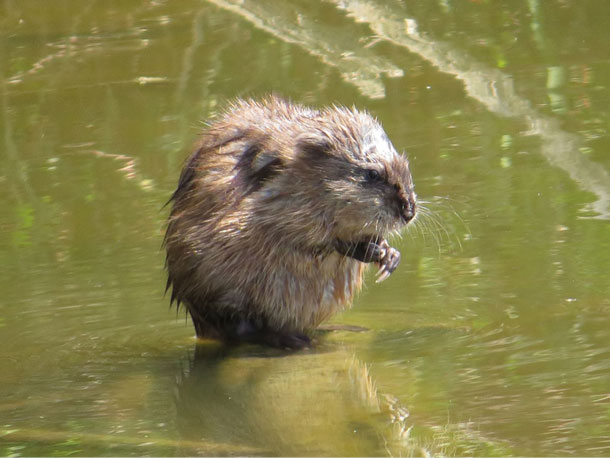
The Muskrat is important to the ecology of wetlands and can be found in a wide range of habitats. (Photo: Jim Kennedy, Flickr, CC By 2.0)
[DRUM]
The earth got bigger and bigger, and where her feet stepped and made footprints, she dropped the seeds, the flowers and the trees and the other plants. So life came to be on earth through the agency of sky woman, who is always remembered among the Haudenosaunee people as a Mother, the first Mother of us all.
[DRUM]
We must listen to our heart beat for the sound of the heartbeat is the first drum and which drum do we hear first, we hear the heartbeat of our mother. even before we are born. We're listening to the music of life and dancing in that water within our mother's body. So when we are born, we're listening for the sound of the drum. We're actually listening to the sound of our mother's heartbeat. The Earth itself when we play the drum, we say the drumbeat is the heartbeat of Mother Earth, and that we as human beings must always remember it when we hear the drum to respect our mothers and respect our Mother Earth.
CURWOOD: Joe Bruchac is a storyteller and Nulhegan Abenaki elder. Joe, thanks so much for taking the time with us today.
BRUCHAC: It was my pleasure, Steve.
CURWOOD: And there's more about Joe's books and stories on the living on earth website that's loe.org
Links
Read more about Joe Bruchac and his stories
To read more about the Menominee Indian Tribe of Wisconsin, click here
Living on Earth wants to hear from you!
Living on Earth
62 Calef Highway, Suite 212
Lee, NH 03861
Telephone: 617-287-4121
E-mail: comments@loe.org
Newsletter [Click here]
Donate to Living on Earth!
Living on Earth is an independent media program and relies entirely on contributions from listeners and institutions supporting public service. Please donate now to preserve an independent environmental voice.
NewsletterLiving on Earth offers a weekly delivery of the show's rundown to your mailbox. Sign up for our newsletter today!
 Sailors For The Sea: Be the change you want to sea.
Sailors For The Sea: Be the change you want to sea.
 The Grantham Foundation for the Protection of the Environment: Committed to protecting and improving the health of the global environment.
The Grantham Foundation for the Protection of the Environment: Committed to protecting and improving the health of the global environment.
 Contribute to Living on Earth and receive, as our gift to you, an archival print of one of Mark Seth Lender's extraordinary wildlife photographs. Follow the link to see Mark's current collection of photographs.
Contribute to Living on Earth and receive, as our gift to you, an archival print of one of Mark Seth Lender's extraordinary wildlife photographs. Follow the link to see Mark's current collection of photographs.
 Buy a signed copy of Mark Seth Lender's book Smeagull the Seagull & support Living on Earth
Buy a signed copy of Mark Seth Lender's book Smeagull the Seagull & support Living on Earth

